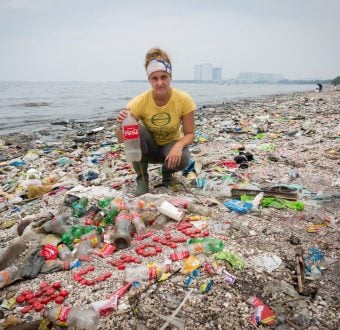The inspection involved three components: one from the air aboard Greenpeace’s 135-foot thermal airship marked with a banner reading “Real Chemical Security Now”; the second from Greenpeace boats patrolling the Delaware River adjacent to the facilities, and concluding on land with an in-person delivery of the inspection reports.
“We know DuPont can convert their plants. They simply lack the will do so,” said Greenpeace Legislative Director Rick Hind. “As recent disasters in the petrochemical industry show, we cannot rely on the industry to regulate itself.”
In June 2007, former DuPont CEO Charles O. Holliday commented on security saying, “I feel very comfortable that we’ve taken all the reasonable steps, but obviously if someone wants to fly an airplane into a plant, it’s very hard to guard against it.”
Although the Department of Homeland Security (DHS) plans to inspect ‘high risk’ chemical plants, they will only inspect 3 percent of the 5,333 “high risk” plants by the end of 2010. Under a temporary law, the DHS also has no authority to require the use of safer chemical processes that would eliminate catastrophic poison gas risks at a chemical facility.
“Putting up fences and cameras won’t protect workers and communities. Even a no-fly zone will only deter law-abiding pilots,” said Hind. “The only foolproof way to safeguard communities from these plants is to use safer common sense chemical processes that eliminate the possibility of a catastrophic accident. Making plants safer also makes them less attractive terrorist targets. In 2009, Clorox announced that they would convert all of their U.S. plants to eliminate these risks. If Clorox can do it, why won’t DuPont?”
Nearly 9 years after the attacks of 9/11, the nation’s chemical plants remain vulnerable to terrorist attack. Chemical plant risk zones frequently extend up to 20 miles downwind into densely populated areas due to the bulk storage or use of poison gases such as chlorine. More than 100 million Americans are put at risk by just 300 of the nation’s “high risk” chemical plants. In 2004, the Homeland Security Council estimated that an attack on a chemical facility would kill 17,500 people, seriously injure 10,000, and send an additional 100,000 people to the hospital.
Since 1999, more than 500 plants have switched to safer and more secure chemicals or processes nationwide, eliminating risks to 40 million Americans. Fifteen chemical facilities in DE, PA and NJ use safer processes eliminating risks to over 14 million people. Greenpeace also issued ‘passed’ inspection reports to the Wilmington Water Pollution Control facility and the Southeast Water Pollution Control Plant in Philadelphia; both facilities have eliminated these risks.
The U.S. House of Representatives passed a bill (HR 2868) on Nov. 6, 2009 that would require the highest risk plants to convert to safer processes where commercially feasible. This bill now moves to the Senate. Four area Senators sit on two key committees that will take up this legislation in June; they are Senators Carper (D-DE); Kaufman (D-DE); Specter (D-PA) and Lautenberg (D-NJ).
In a letter to DuPont CEO Charles O. Holliday in March of 2009, Greenpeace suggested that the company switch to less hazardous processes and support legislation to eliminate these risks as the railroad industry has. In November of 2009, Clorox announced that it would convert all of its factories using chlorine gas to safer chemical processes, thereby eliminating catastrophic risks to 13.6 million Americans.
Terrorism experts from agencies such as DHS, the EPA, and the Government Accountability Office have documented the nation’s vulnerability to toxic releases at U.S. chemical plants and the need to require safer processes. An accident could result in a deadly release similar to that experienced in Bhopal, India in 1984, when a gas leak at a pesticide plant killed 8,000 within three days.
This was the first flight of Greenpeace’s thermal airship in the United States.
Other contacts: Contact: Jane Kochersperger, Media Officer, Greenpeace, (202)-680-3798, [email protected] or Rick Hind, Greenpeace Legislative Director, (202) 413-8513 (on site)
Photos: http://www.flickr.com/photos/greenpeaceusa09/4616618936/in/set-72157624081466780/
Contact: Tim Aubry, Greenpeace Visuals Director, [email protected]
Twitter: http://twitter.com/greenpeaceusa

